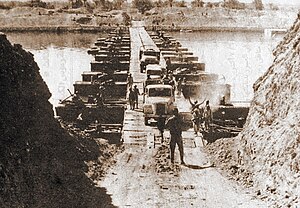1973 Yom Kippur War
| Yom Kippur War/October War |
| Part of the Cold War and Arab–Israeli conflict
|

Egyptian forces crossing the Suez Canal on October 7 |
| Date |
October 6–25, 1973 |
| Location |
Both banks of the Suez Canal, Golan Heights and surrounding regions |
| Result |
Israeli military victory
- Political gains for Egypt and Israel
- 1978 Camp David Accords
|
Territorial
changes |
- The Egyptian army occupied the eastern coast of the Suez Canal with the exception of the Israeli crossing point near Deversoir.
- The Israeli army occupied sixteen hundred square kilometers of territory on the southwestern coast of the Suez Canal, within 100 km from Cairo, and encircled an Egyptian enclave in the east bank
- The Israeli army occupied five hundred square kilometers of the Syrian Bashan, on top of the Golan Heights, which brought it within 20 miles of Damascus.
|
|
| Belligerents |
 Israel Israel |
Expeditionary forces:
Supported by:
|
| Commanders and leaders |
|
|
|
| Strength |
- 375,000–415,000 troops
- 1,700 tanks
- 3,000 armored carriers
- 945 artillery units
- 440 combat aircraft
|
Egypt:
- 650,000–800,000 troops (200,000 crossed)
- 1,700 tanks (1,020 crossed)
- 2,400 armored carriers
- 1,120 artillery units
- 400 combat aircraft
- 140 helicopters
- 104 Navy vessels
- 150 surface to air missile batteries (62 in the front line)
Syria:
- 150,000 troops
- 1,200 tanks
800–900 armored carriers
- 600 artillery units
Expeditionary Forces*:
- 100,000 troops
- 500–670 tanks
- 700 armored carriers
Cuba:
Morocco:
- 5,500 troops
- 30 tanks
- 52 combat aircraft
Saudi-Arabia:
3,000 troops
Total:
- 914,000–1,067,500 troops
- 3,430–3,600 tanks
- 3,900–4,000 armored carriers
- 1,720 artillery units
- 452 combat aircraft
- 140 helicopters
- 104 navy vessels
- 150 surface to air missile batteries
|
| Casualties and losses |
- 2,521–2,800 dead
- 7,250–8,800 wounded
- 293 captured
- 1,063 tanks destroyed, damaged or captured
- 407 armored vehicles destroyed or captured
- 102–387 aircraft destroyed
|
Syria:
- 3,000–3,500 dead
- 392 captured
Iraq:
- 278 dead
- 898 wounded
- 13 captured
Jordan:
Morocco:
Total casualties:
- 8,000–18,500 dead
- 18,000–35,000 wounded
- 8,783 captured
- 2,250–2,300 tanks destroyed
- 341–514 aircraft destroyed
- 19 naval vessels sunk
|
Israeli military victory
Expeditionary forces:
Supported by:
The Yom Kippur War, Ramadan War, or October War (Hebrew: מלחמת יום הכיפורים, Milẖemet Yom HaKipurim, or מלחמת יום כיפור, Milẖemet Yom Kipur; Arabic: حرب أكتوبر, Ḥarb ʾUktōbar, or حرب تشرين, Ḥarb Tišrīn), also known as the 1973 Arab–Israeli War, was a war fought by a coalition of Arab states led by Egypt and Syria against Israel from October 6 to 25, 1973. The fighting mostly took place in the Sinai and the Golan Heights, territories that had been occupied by Israel since the Six-Day War of 1967. Egyptian President Anwar Sadat wanted also to reopen the Suez Canal. Neither specifically planned to destroy Israel, although the Israeli leaders could not be sure of that.
The war began when the Arab coalition launched a joint surprise attack on Israeli positions in the Israeli-occupied territories on Yom Kippur, the holiest day in Judaism, which also occurred that year during the Muslim holy month of Ramadan. Egyptian and Syrian forces crossed ceasefire lines to enter the Sinai Peninsula and the Golan Heights respectively. Both the United States and the Soviet Union initiated massive resupply efforts to their respective allies during the war, and this led to a near-confrontation between the two nuclear superpowers.
...
Wikipedia

